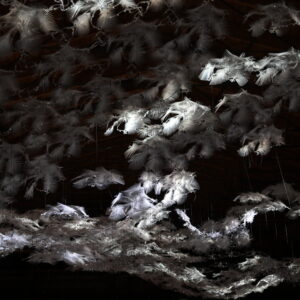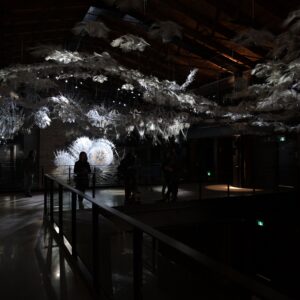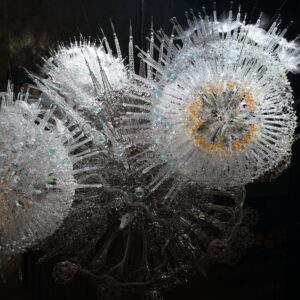Meander
Tapestry Hall
Cambridge, CAN 2020
Meander is a large-scale immersive testbed environment constructed within a historic warehouse building at the centre of a residential highrise development in Cambridge, Ontario. The meshwork scaffolds which comprise the testbed are organized as a series of species within an artificial ecosystem, gently flexing and responding to the movement of viewers. Similar to natural environments such as rivers and clouds, large groups of parts pass physical impulses and data signals back and forth, enabling the entire environment to work as an interconnected whole. The innovations in Meander suggest ways of making adaptive, sensitive buildings of the future.
The geometric structures seen in Meander use interlinking, flexible lattices that behave like textiles and natural shell structures. Overlapping strands of materials balance each other within doubly-curved conical stem-shaped forms. The skeletal forms create strong inner and outer shells much in the same way that natural bone structures are formed. Rather than static, closed boundaries, thresholds of new buildings could be deliberately fragile and delicate. By interlinking many delicate parts, robust structures can handle intense amounts of force, accommodating the increasing storms and turbulence of our changing climate. The interwoven structures are developed to handle shifting, unstable environments and are capable of absorbing strong forces. Instead of the heavy masses of material used in traditional building, this kind of process uses extremely light, thin sheets of material, reducing material use and saving energy.
Sensors embedded within the environment signal the presence of occupants, and send ripples of light, motion and sound through the system in response. Software is organized in clusters of interconnected groups that can communicate with neighboring groups resulting in global behavior connections throughout the system. A second layer of sensors provides ‘proprioception’ – internal sensing. Like the human body’s ability to know its own actions, this layer of information provides each cluster of mechanisms with information about action happening within its local structure. By using this constantly-cycling information, the systems can adapt their behavior and form new responses. By creating artificial environments that can learn, this research might help develop new mutual relations and healthy exchanges with urban environments.
The project includes an immersive distributed soundscape developed in collaboration with the Netherlands-based group 4DSOUND. The composition is carried within arrays of custom speakers embedded throughout the environment, making constantly-shifting sound that responds to visitors. Alongside the sculpture, a Meander STEAM curriculum foregrounds a space where young learners can engage in a collaborative web of science, technology, engineering, arts and math to playfully form new solutions for sustainable technology and design. The interpretive exhibit invites visitors to view detailed visualizations of the interactive systems within the sculpture and includes prototype samples and videography documenting the development of the work.Early studies for Meander included trips down the Grand River, studying its water flows and diverse wildlife. Like the scouring and depositing forces that create the Grand’s oxbow shape, Meander’s form is the result of accumulations of material. Flexible geometric tiles make up the undulating membrane surfaces of the sculpture. Live data that monitors the flow of the River continues to feed directly into the interactive environment, creating background swells of light and sound.
Project Leads
- Philip Beesley
- Rob Gorbet
- Matt Gorbet
- Timothy Boll
- Michael Lancaster
- Ilana Hadad
- Karen Zwart Hielema
- Mark Francis
- Anne Paxton
- Ellie Hayden
Collaborators
Salvador Breed, 4DSOUND
Poul Holleman, 4DSOUND
Iris van Herpen, Atelier Iris van Herpen
Lucinda Presley, ICEE Success Foundation
Research Leads
Rachel Armstrong
Sarah Bonnemaison
Colin Ellard
Dana Kulić
LASG Studio
Gabriella Bevilacqua
Bria Cole
Filipe Costa
Kevan Cress
Jochem Esser
Alix Falconer
Conor Fitzgerald
Adam Francey
Jonathan Gotfryd
Sascha Hastings
Lisa Jiang
Zubin Khabazi
Bianca Weeko Martin
Mike Matyszczuk
Nikola Miloradovic
Niel Mistry
Farhan Monower
Melanie Neves
Muhammad Tahir Pervaiz
Sophia Rahn
Elliot Reid
Severyn Romanskyy
Stephen Ru
Nathanael Scheffler
Mackenzie Van Dam
Oliver Witham
Meghan Won
Aidan Wyber
Production
Buthaina Ahmed
Jessica Bola
Mara Caza
Gizem Cetin
Laura Chen
Selina Deng
Stacy Florendo
Zara Glaser
Gal Hadad
Roni Haravon
Thai Huynh
Islam Idris
Matin Mithras
Asli Ozuak
Anna Pogossyan
Shira Yavor
Sharanka Prince Yogarajah
Kaleman Silva
Chanel Vinet
Adam Weaver
Melissa Zhang Zhang
Production Assistants
- Mehrnaz Abdoos
- Rand Aldoori
- Isabel Amos
- Arwa Ali
- Jibril Ali
- Joshua-Andre Amante
- Marwah Alabbad
- Kayvon Bahrami
- Cesar Barahona
- Brandon Bernard
- Jacob Bonus
- Elliott Bork
- Lyn Bui
- Jordan Buttress
- Sigi Buzi
- Mae Cyazanne Cabaluna
…
- Vicky Cao
- Haodong Chen
- Lily Chen
- Nai-Xin Cheng
- Jamie Cheung
- Sreela Chowdhury
- Katty Cybulski
- Alex Dacosta
- Mariana De Queiroz
- Isabel Delaney
- Farhan Dhanani
- Mohamadou Dibbasey
- Thanh Do
- Elsa Drummond
- Nada El Baytam
- Jonathan Espana
- Dima Ghazal
- Summer Ghaznavi
- Claire Goble
- Jordan Goldbloom
- Julia Gorbet
- Anna Halleran
- Olgha Hanna
- Elaine Hoang
- Alice Huang
- Nawal Jameel
- Ruo Jia
- Alicia Jin
- Angela Jin
- Ana Jorge-Moore
- Natasha Jorge-Moore
- Daniella Kalinda
- Atramn Kamson
- Jeremy Keyzer
- Christina Kim
- Jessica Leon
- Yanling Li
- Stefan Lim
- Diane Lin
…
- Fangyu Lu
- Victoria Lyu
- Laura Mattar
- Rachel McKenna-Marshall
- Sofia Munera
- Ali Musa
- Amy Ngo
- Kavin Nguyen
- Zehna Odwar
- Ethan Paddock
- Jennifer Pham
- Shawnique Rhooms
- Noah Rosenblum
- Sonia Sarshar
- Megan Schoeppich
- Nathan Shakua
- John Sicat
- Maya Skarzenski-Smith
- Anna Sliwka
- Isabella Suppa
- Ploypailin Sudsaung
- Leah Thompson
- Tyler Tian
- Johanna Tsai
- Adriana Valencia
- Lena von Buren
- Selina Wang
- Eileen Xiao
- Ying Yang
- Kristelle Yau
- Xiaying Yu
- Bei Zhou
Supported by: City of Cambridge, HIP Developments Inc., Social Sciences and Humanities Research Council of Canada, University of Waterloo, Canada Council for the Arts, Consulate General of the Kingdom of the Netherlands in Toronto, Ontario Arts Council, Toronto Arts Council, Mitacs. This project has received funding from the European Union’s Horizon 2020 research and innovation Programme under grant agreement No 824160.























